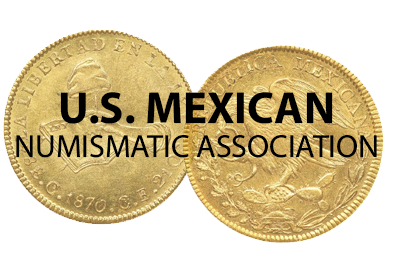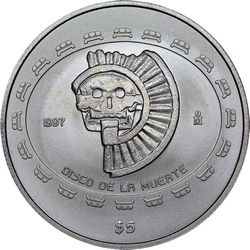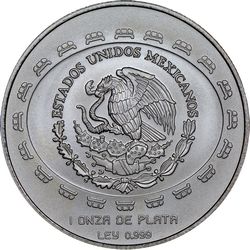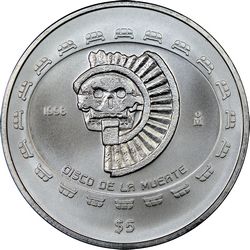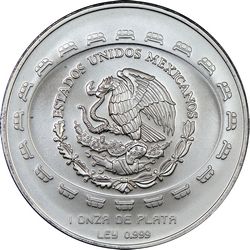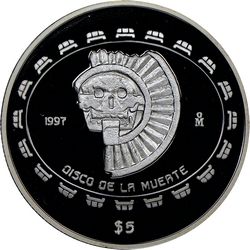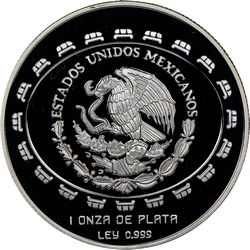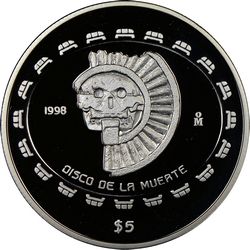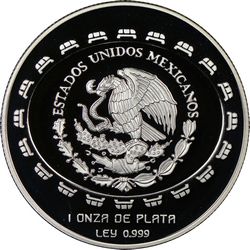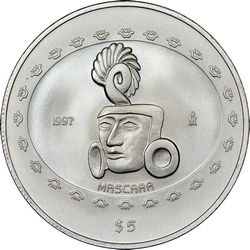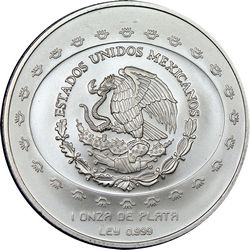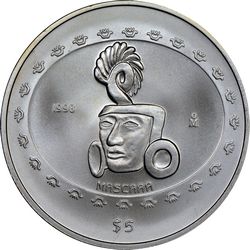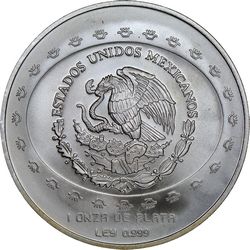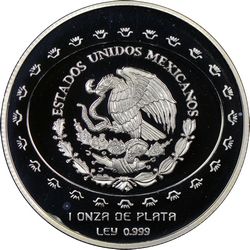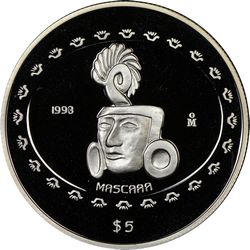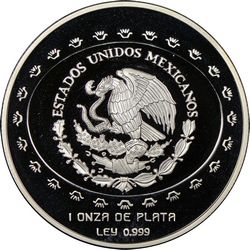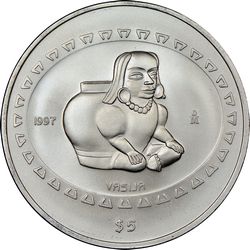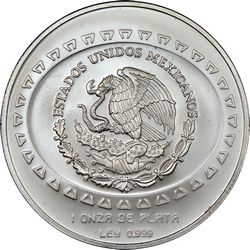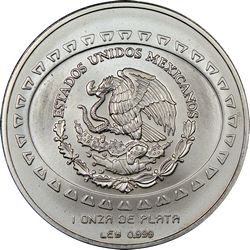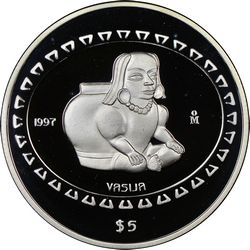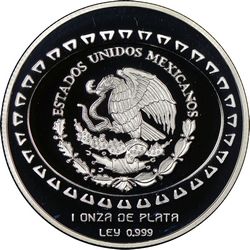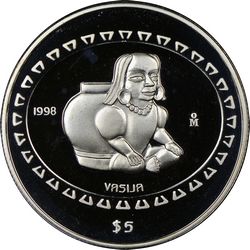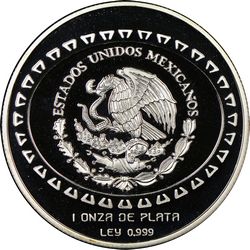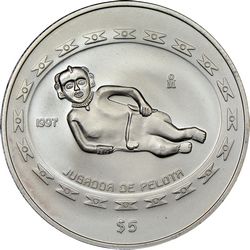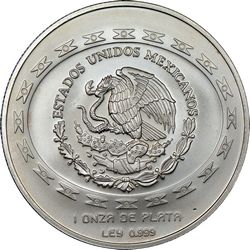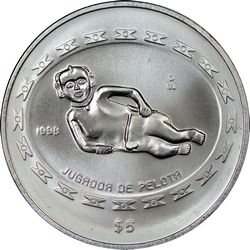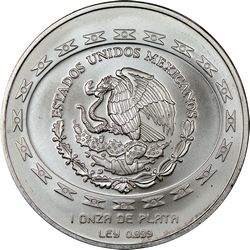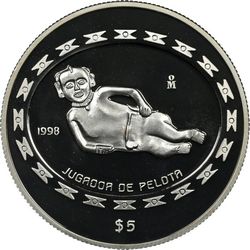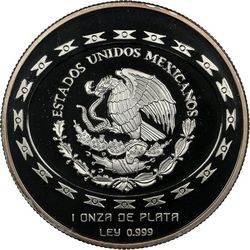Pre-Columbian Series – Teotihuacan Collection – Silver 1 Oz. (Uncirculated & Proof)
by Alberto Rodriguez
Introduction
Long before the Spanish set foot on Mesoamerican soil, a powerful metropolis emerged in the valley of Mexico, formed by a convergence of settlements as early as the second century BCE. The city, later named Teotihuacán by the Aztecs, “the city of the gods”, became one of the largest and most influential urban centers in the ancient world. At its peak, it boasted more than 2,000 structures and over 100,000 inhabitants, laid out in a masterful grid with monumental pyramids along the Avenue of the Dead.
And yet, despite its scale, Teotihuacán’s builders left no written records. The civilization’s rise and sudden collapse remain shrouded in mystery. This silence, alongside the city’s sheer ambition and symmetry, makes it one of the most compelling subjects in the Pre-Columbian silver series.
This fifth installment focuses on the 1oz silver Teotihuacán Collection, a series of four coins that includes some of the rarest and most sought-after issues in the entire Pre-Columbian program. Collectors widely believe that three of the four coins in this set were minted in far lower quantities than officially reported, with evidence and availability suggesting true mintages closer to 100 pieces, or potentially even fewer. From the haunting Disco de la Muerte to the poised Jugador de Pelota, each design captures a piece of Teotihuacán’s visual and spiritual language, one of sacrifice, ritual, and cosmic alignment.
As with my previous articles, this installment will explore each coin’s historical backdrop, design complexity, and mintage realities accounting for restrikes and for surviving mintage. I will provide detailed tables and commentary to help collectors navigate not just the aesthetics, but the scarcity and survival of these elusive pieces.
Although the Teotihuacán set does not contain speculative varieties, its coins stand apart for their beauty, rarity, and mysterious undersupply thus making this collection one of the crown jewels of the entire series. Like the ancient city itself, these coins deserve a prominent place in any collector’s imagination.
Before we begin, it is once again worth highlighting two factors that have obscured collectors’ understanding of mintages for this particular series. As highlighted in earlier articles, both online coin directories and authoritative catalogs only publish the original mintages from when the coins were first released, but leave out officially published restrikes, by the Banco de México. The Pre-Columbian series, in fact, minted additional strikes in the years 2000 – 2011.
Another factor to take into consideration is what I have termed the Melted Factor. Anecdotally several folks in the business, both in Mexico and the United States, have suggested that during the parabolic silver price run up of 2010- 2011, 35%-50% of silver Pre Columbians have been melted during that time period. Further evidence from Mexican coin collectors and old online message board posts suggests this series was long treated like bullion and has long sold for spot. Many of the surviving pieces also have evidence of acid tests on the surface. Taking this Melted Factor into consideration provides a more accurate representation of available mintage today. Since the publication of the first couple of my articles, it has been brought to my attention by readers of this journal, that proof coins have always commanded a market premium versus their Brilliant Uncirculated counterparts and as such, the melted factor on proofs is likely to be close to the lower bound of 35%, whereas the Brilliant Uncirculated are likelier to converge to the 50% estimate. Additionally, collectors are finding it much harder to find high grade uncirculated versions of the coins versus their proof counterparts.
Disco de la Muerte
The Disco de la Muerte (Disc of Death) 1 ounce silver coins feature a dramatic rendering of a pre-Columbian stone sculpture: a human skull centered within a circular disc, surrounded by radiating lines. The original artifact was broken around the edges, possibly during a raid amid Teotihuacán’s decline, and is now housed in the Museo Nacional de Antropología in Mexico City.
The coin’s border design is derived from a decorative motif found on a conical, three-legged vessel from Teotihuacán, believed to reside in the same museum.
Issued in 1997 and 1998, these 1-ounce silver coins were struck in both Brilliant Uncirculated and Proof finishes and carry a face value of 5 pesos. Among collectors, they are considered some of the most visually compelling coins in the Pre-Columbian program.
This particular piece stands out as one of my personal favorites in the entire series. It shares that honor with the Brasero Efigie of Tlaloc, which I discussed in my first article. The Disco de la Muerte, with its stark symbolism and haunting aesthetic, captures the essence of Teotihuacán like few other designs ever have.
Disco de la Muerte – Brilliant Uncirculated (BU) Variety Overview
The Brilliant Uncirculated coin has as reverse a broken Disco de la Muerte at the center of the field with the date to the left, the mintmark to the right (MMR), and DISCO DE LA MUERTE in the exergue below. An ornamental border surrounds the horizontal oval field with N$5 below. The design of the 1997 and 1998 editions is identical, only distinguished by the year.
The obverse of the coin displays the national coat of arms with the eagle facing left with its feathers resembling plates of armor on the center of a horizontal oval field. Above it, the legend ESTADOS UNIDOS MEXICANOS, and below it, a half-wreath of oak and laurel. Surrounding the field is an ornamental border. Below the border is displayed 1 ONZA DE PLATA, and further below LEY 0.999
Disco de la Muerte 1997
$5 New Pesos (MMR) Brilliant Uncirculated
Disco de la Muerte 1998
$5 New Pesos (MMR) Brilliant Uncirculated
There were 3,000 original strikes for the 1997 issue according to the Whitman Encyclopedia of Mexican Money. The three primary sources typically referenced in these matters: The Standard Catalog of World CoinsMichael, Thomas, Tracy L. Schmidt, and Richard Giedroyc 2019 Standard Catalog of World Coins. Stevens Point, WI: Krause Publications, 2018., Whitman Encyclopedia of Mexican MoneyBailey, Don, and Lois. Whitman Encyclopedia of Mexican Money, Volume 2: Modern Coins of Mexico, 1905 to Date. Atlanta, GA: Whitman Publishing, LLC, 2015, and NumistaNumista Mexico Pre-Columbian Teorihuacan Coinage. https://en.numista.com/catalogue/series_list.php each present differing figures for both the 1997 and 1998 editions, creating a common challenge for reconciling original mintages across Mexican numismatics.
For 1997, Whitman lists 3,000 original strikes, Numista reports 3,500, and the Standard Catalog places the figure at 4,700. The 1998 edition shows even more divergence: Whitman lists 2,400 original strikes, Numista reports 3,400, and Standard Catalog agrees at 3,400. As in prior articles, such conflicting figures necessitate a careful evaluation of source credibility. I have always defaulted to Don Bailey’s numbers as published in the Whitman Encyclopedia, due to his long-standing and close relationships within the Mexican numismatic world, including direct insights from the Banco de México Mint and influential figures within the coin community.
The additional restrikes from the years 2000–2011 are published on the Banco de México’s websiteBanxico.org.mx Economic Information System (SIE) Coins and Medals – CM27, Annual, Pieces, Flows., but they do not differentiate between the 1997 and 1998 types. These additional strikes total 1,400 across both years. However, unlike other issues, I have compelling anecdotal evidence to strongly suggest the entirety of these restrikes were dated 1997. In my personal collection of over 50 Brilliant Uncirculated Disco de la Muerte specimens, only four are 1998s. The 1998 variety, while not at the extreme scarcity level of a 500-mintage coin, remains frustratingly elusive on the secondary market. Based on this collector experience and reinforced by broader observations from the community, I am inclined to allocate the full restrike count of 1,400 to the 1997 issue when computing totals.
With this approach, the grand total for the 1997 Disco de la Muerte becomes 4,400, while the 1998 remains at its original 2,400 strikes. Applying the Melted Factor, discussed in the introduction (35-50%) leaves us with an estimated survival mintage of 2,200 - 2,860 for the 1997 variety and 1,200 – 1,560 for the 1998 variety. These figures help underscore the rarity of both issues in true Brilliant Uncirculated condition, especially the 1998 edition, which is not only lower in original mintage but also significantly harder to locate in the wild, both online and at major coin shows.
| 1oz Silver MS Pre-Columbian Series - Disco de la Muerte | |||||
| Original Mintage | Restrikes | Total Including Restrikes | Estimated Minimum Surviving | Estimated Maximum Surviving | |
| 1997 5 Pesos MMR | 3,000 | 1,400 | 4,400 | 2,200 | 2,860 |
| 1998 5 Pesos MMR | 2,400 | 0 | 2,400 | 1,200 | 1,560 |
Disco de la Muerte – Proof Variety Overview
The 1oz Disco de la Muerte silver proof shares the same coin elements as its Brilliant Uncirculated counterpart but is further distinguished by a mirrored inner field and border area on both sides with a raised and frosted denomination on the reverse as well as a raised and frosted legend on the obverse. Similar to the Brilliant Uncirculated, both a 1997 and 1998 variety were released for the proof edition of this coin design.
Disco de la Muerte 1997
$5 New Pesos (MMR) Proof
Disco de la Muerte 1998
$5 New Pesos (MMR) Proof
For the 1997 and 1998 issues of the 1oz silver Disco de la Muerte Proof coin, we once again encounter a complex landscape of mintage figures. According to Whitman the 1997 Proof had an original mintage of 1,600, while the 1998 came in at 506. Numista lists the figures at 1,800 and 500 respectively, while the Standard Catalog of World Coins reports 3,206 for the 1997 and 500 for the 1998. Given these discrepancies, I continue to rely most heavily on the numbers published in the Whitman Encyclopedia.
Bailey’s estimate of 506 for the 1998 Proof strikes me as slightly peculiar, and I suspect it reflects a rounding or transcription anomaly, particularly when both Numista and the Standard Catalog report a flat 500. Given my own collecting experience, I am inclined to accept the 500 figure as definitive. The 1998 Proof is extraordinarily scarce, even more so than the BU version. During my time collecting, I have personally only ever seen three legitimate sales of the 1998 Proof, and of those, I was fortunate enough to secure two. Its elusiveness is consistent with a very low original mintage and further reinforces my belief that none of the subsequent restrikes pertain to this variety.
Banco de México’s published records show an additional 1,800 Proof coins struck between 2000 and 2011, though they do not distinguish between varieties, but, for the reasons stated, I assign the entire restrike count to the 1997 issue.
Using this allocation, the grand total combined per 1997 and 1998 variety is 3,400 and 500 respectively and applying the Melted Factor leaves us with an estimated survival mintage of 1,700 - 2,210 for the 1997 variety and 250 -325 for the 1998 variety. These figures underscore the elite scarcity of the 1998 Disco de la Muerte Proof, which ranks among the most elusive and sought-after coins in the entire Pre-Columbian series. Its low survival estimate, combined with real world market invisibility, confirms its position as a cornerstone for any serious collector of Mexican numismatics.
| 1oz Silver PF Pre-Columbian Series - Disco de la Muerte | |||||
| Original Mintage | Restrikes | Total Including Restrikes | Estimated Minimum Surviving | Estimated Maximum Surviving | |
| 1997 5 Pesos MMR | 1,600 | 1,800 | 3,400 | 1,700 | 2,210 |
| 1998 5 Pesos MMR | 500 | 0 | 500 | 250 | 325 |
Máscara
The Máscara (Mask) 1 ounce silver coin showcases a striking representation of a Teotihuacán funerary mask, believed to have adorned the burial attire of high-ranking individuals in the ancient city. The design captures the stoic and dignified features of a stone mask, complete with elaborate earrings and an ornamental headdress, reflecting the ceremonial artistry of pre-Columbian Mesoamerica.
The border surrounding the central figure is inspired by a decorative motif found on another Teotihuacán artifact, an intricately encrusted turquoise mask, highlighting the refined aesthetics and symbolic layering that defined the culture’s elite craftsmanship.
Issued in 1997 and 1998, these 1-ounce silver coins were minted in both Brilliant Uncirculated and Proof finishes and carry a face value of 5 pesos. Among enthusiasts of the Pre-Columbian series, the Máscara stands out for its solemn beauty and cultural reverence, offering a stark contrast to the more fearsome or abstract motifs seen on other coins in the collection.
Máscara – Brilliant Uncirculated (BU) Variety Overview
The Brilliant Uncirculated coin has as reverse a Teotihuacán funerary mask at the center of the field, with the date to the left, the mintmark to the right (MMR), and MÁSCARA in the exergue below. An ornamental border surrounds the horizontal oval field with N$5 displayed below. The design of the 1997 and 1998 editions is identical, distinguished only by the year.
The obverse of the coin displays the national coat of arms with the eagle facing left, its feathers resembling plates of armor, at the center of a horizontal oval field. Above it, the legend ESTADOS UNIDOS MEXICANOS; below it, a half- wreath of oak and laurel. Surrounding the field is an ornamental border. Below the border appears the legend 1 ONZA DE PLATA, and further below LEY 0.999.
Máscara 1997
$5 New Pesos (MMR) Brilliant Uncirculated
Máscara 1998
$5 New Pesos (MMR) Brilliant Uncirculated
While multiple reference catalogs list this design, the original mintage figures vary depending on the source, once again illustrating the challenge of reconciling production data across Mexican numismatics. For 1997, both Whitman and Numista report 4,500 original strikes, while the Standard Catalog of World Coins lists a higher figure at 5,200. For 1998, Whitman places the figure at 2,200, Numista at 2,000, and the Standard Catalog also at 2,000. As in earlier analyses, we default to Don Bailey’s counts published in the Whitman Encyclopedia.
An additional 3,700 restrikes of the Máscara coin were issued between 2000 and 2011. Banco de México’s official figures confirm the total but do not differentiate between the two years. In the case of Máscara, I have encountered a steady appearance of both 1997 and 1998 issues in Brilliant Uncirculated condition. While not conclusive, this supports an assumption of a proportional distribution of the 3,700 restrikes, namely 2485 for 1997 and 1,215 for 1998.
With the additional strike figures the grand total combined per 1997 and 1998 variety is 6,985 and 3,415 respectively and applying the Melted Factor leaves us with an estimated survival mintage of 3,493 - 4,541 for the 1997 variety and 1,708 - 2,220 for the 1998 variety.
| 1oz Silver MS Pre-Columbian Series - Mascara | |||||
| Original Mintage | Restrikes | Total Including Restrikes | Estimated Minimum Surviving | Estimated Maximum Surviving | |
| 1997 5 Pesos MMR | 4,500 | 2,485 | 6,985 | 3,493 | 4,541 |
| 1998 5 Pesos MMR | 2,200 | 1,215 | 3,415 | 1,708 | 2,220 |
Máscara – Proof Variety Overview
Máscara 1997
$5 New Pesos (MMR)
Máscara 1997
$5 New Pesos (MMR)
The proof varieties share the same coin elements as its Brilliant Uncirculated counterpart but are further distinguished by a mirrored inner field and border area on both sides with a raised and frosted denomination on the reverse as well as a raised and frosted legend on the obverse. Similar to the Brilliant Uncirculated, both a 1997 and 1998 variety were released for the proof edition of this coin design.
According to the Whitman Encyclopedia of Mexican Money, the 1997 Proof had an original mintage of 1,800, while the 1998 came in at a surprisingly high 1,306. In contrast, Numista and the Standard Catalog of World Coins both list 500 for the 1998 issue, with Numista mirroring Whitman at 1,800 for 1997 and the Standard Catalog reporting a higher 2,906 for the same year. I typically rely on Whitman as the anchor source, but the 1998 Proof Máscara is a notable exception. In this instance, I believe the Whitman figure of 1,306 for the 1998 issue to be inaccurate and overstated, possibly the result of a data transcription error or the conflation of internal Mint records.
Over the course of my collecting, I have encountered only four confirmed owners of the 1998 Proof Máscara. Two of them acquired their coins early on through direct channels in Mexico, shortly after release. Notably, one of these examples originally came from an old-school Mexican collector, a numismatist deeply rooted in earlier eras such as the Revolutionary period who, in keeping with the traditions of that time, never submitted his coin for grading. It was only after being resold to a more modern collector that the piece eventually entered the grading census. This detail speaks to a broader likelihood: that additional specimens may reside quietly in older, ungraded collections, held by collectors for whom grading was never a priority. That possibility, however, does little to change the coin’s extreme market invisibility today, supporting the perception that the 1998 Proof Máscara, even if minted to a higher count, is among the least encountered coins of the entire series.
Banco de México’s published restrike data confirms an additional 1,900 Proof coins struck between 2000 and 2011. In this case, I find it nearly impossible that any 1998 restrikes were produced. Given the extreme rarity and invisibility of the 1998 Proof Máscara, I am confident that 100% of the restrikes belong to the 1997 issue.
Using this allocation, the revised total figures are 3,700 (1,800 plus 1,900) for 1997 and 500 for 1998. Applying the Melted Factor leaves us with an estimated survival mintage of 1,850 - 2,405 for the 1997 variety and 250 - 325 for the 1998 variety:
These figures help underscore the elite-level scarcity of the 1998 Máscara Proof, not just on paper but in actual availability across the marketplace. Its extreme rarity, low survival estimate, and vanishingly rare real-world appearances place it among the most enigmatic and prized pieces of the entire Pre-Columbian silver series.
| 1oz Silver PF Pre-Columbian Series - Mascara | |||||
| Original Mintage | Restrikes | Total Including Restrikes | Estimated Minimum Surviving | Estimated Maximum Surviving | |
| 1997 5 Pesos MMR | 1,800 | 1,900 | 3,700 | 1,850 | 2,405 |
| 1998 5 Pesos MMR | 500 | 0 | 500 | 250 | 325 |
Vasija
The Vasija (Vessel) 1-ounce silver coin features a sculptural rendering of a Teotihuacán container shaped as a seated human figure, modeled after an artifact housed in Mexico’s National Museum of Anthropology. These human-formed vessels are thought to have held ritual significance, possibly representing deities or high-ranking individuals in ancient ceremonies.
The coin’s border draws from the headdress design of a Teotihuacán sculpture, adding symbolic depth and stylistic cohesion. The overall design reflects the refined craftsmanship and spiritual nuance that defined Teotihuacán’s ceremonial art.
Issued in 1997 and 1998, these 1-ounce silver coins were minted in both Brilliant Uncirculated and Proof finishes and carry a face value of 5 pesos. Among Pre-Columbian collectors, the Vasija is admired for its quiet dignity and cultural resonance, offering a contemplative counterpoint within the broader series.
Vasija – Brilliant Uncirculated (BU) Variety Overview
The Brilliant Uncirculated coin features a Teotihuacán vessel-figurine at the center of the reverse design, depicting a seated human-shaped container from the ancient city’s ceremonial art. The date appears to the left, the mintmark to the right (MMR), and the word VASIJA is inscribed in the exergue below. An ornamental border surrounds the horizontal oval field, with $5 displayed at the base. The design remained unchanged across the 1997 and 1998 issues, differing only by year.
The obverse bears the national coat of arms of Mexico: an eagle facing left with feathers resembling plates of armor, grasping a serpent atop a cactus, all set within a horizontal oval field. The legend ESTADOS UNIDOS MEXICANOS arcs above, with a half-wreath of oak and laurel below. This is framed by an ornamental border. Below the border is the inscription 1 ONZA DE PLATA, with LEY 0.999 further below.
Vasija 1997
$5 New Pesos (MMR) Brilliant Uncirculated
Vasija 1998
$5 New Pesos (MMR) Brilliant Uncirculated
For the 1997 issue, both Whitman and Numista report 4,500 strikes, while the Standard Catalog lists a higher mintage of 5,300. The 1998 edition shows closer alignment: Whitman reports 2,300 strikes, while both Numista and the Standard Catalog list 2,000. While the variance here is narrower than with other coins in the Teotihuacan series, it nevertheless reinforces the importance of selecting a consistent benchmark. As before, I defer to Don Bailey’s figures as published in the Whitman Encyclopedia.
Restrike figures from 2000 to 2011 are listed on the Banco de México’s official site, which shows a combined 3,800 pieces for the Vasija coin. However, no breakdown is provided between 1997 and 1998 dated restrikes so I again dustribute the restrikes in proportion to the original Whitman mintage ratio. With this, the adjusted total mintages become 7,015 (4,500 original + 2,515 restrikes) for 1997 and 3,585 (2,300 original + 1,285 restrikes) for 1998. Applying the same survival rate - estimating that 35–50% of coins no longer survive, due to loss, damage, or melting -we derive the following survival ranges: 3,508–4,560 for 1997 and 1,793–2,331 for 1998.
These figures highlight the comparative scarcity of both BU issues, especially in high grade. While the 1997 Vasija is more available than its 1998 counterpart, both remain elusive on the secondary market. The 1998 issue, with an original mintage nearly half that of the 1997 and restrikes allocated accordingly, is particularly challenging to source in premium Brilliant Uncirculated condition.
| 1oz Silver MS Pre-Columbian Series - Vasija | |||||
| Original Mintage | Restrikes | Total Including Restrikes | Estimated Minimum Surviving | Estimated Maximum Surviving | |
| 1997 5 Pesos MMR | 4,500 | 2,515 | 7,015 | 3,508 | 4,560 |
| 1998 5 Pesos MMR | 2,300 | 1,285 | 3,585 | 1,793 | 2,331 |
Vasija – Proof Variety Overview
The proof varieties share the same coin elements as its Brilliant Uncirculated counterpart but are further distinguished by a mirrored inner field and border area on both sides with a raised and frosted denomination on the reverse as well as a raised and frosted legend on the obverse. Similar to the Brilliant Uncirculated, both a 1997 and 1998 variety were released for the proof edition of this coin design.
Vasija 1997
$5 New Pesos (MMR) Proof
Vasija 1997
$5 New Pesos (MMR) Proof
For the 1997 and 1998 issues of the 1oz silver Vasija Proof coin, we again encounter the all-too-familiar challenge of navigating a mintage landscape riddled with contradictions. According to Whitman the 1997 Proof coin was struck in a quantity of 1,800, while the 1998 issue is reported at 1,406. In contrast, Numista lists the 1997 at 1,800 and the 1998 at only 500, a figure echoed by other modern collectors. The Standard Catalog of World Coins, however, takes a more expansive view, listing 3,006 Proof coins for both years, thereby muddying the waters further.
I choose to anchor my estimates to the Whitman figures for 1997. However, the figure of 1,406 for 1998 seems overstated and inconsistent with the coin’s extreme rarity in today’s market. Instead, I align more closely with Numista’s 500 mintage, already a low number, yet one that still feels too high based on real world observations. Simply put, the 1998 Vasija behaves more like a coin of 100. Its visibility in the collector’s market is extraordinarily low, mirroring the near invisibility of the 1998 Máscara.
Over years of active collecting, I have personally encountered only a handful of 1998 Vasija Proofs in any form, graded or raw. The few collectors who hold them typically acquired their coins through direct channels in Mexico or obscure private sales. One such piece came from a longtime Mexican collector (the same one mentioned earlier) with no interest in grading and only entered the grading population after being resold. This anecdote reinforces the possibility that additional pieces exist in raw collections, tucked away by traditionalists for whom grading is irrelevant. Even so, this does little to affect the coin’s practical availability, which remains so low that it rivals or even exceeds the scarcity of the 1998 Máscara.
Banco de México’s official restrike records further complicate the picture, showing that 2,000 additional Proof coins were minted between 2000 and 2011 but without differentiating between the 1997 and 1998 varieties. Given the immense difficulty of locating even a single 1998 Vasija, I am confident attributing 100% of the restrikes to the 1997 issue.
So, the grand total combined per 1997 and 1998 variety is 3,800 and 500 respectively and applying the Melted Factor leaves us with an estimated survival mintage of 1,900 - 2,470 for the 1997 variety and 250 - 325 for the 1998 variety. 1998 These estimates highlight the elite-tier rarity of the 1998 Vasija Proof. On paper, its mintage might read 500, but it’s true presence in the marketplace feels closer to 100. This coin stands as one of the most elusive and enigmatic entries in the entire Pre-Columbian silver series.
| 1oz Silver PF Pre-Columbian Series - Vasija | |||||
| Original Mintage | Restrikes | Total Including Restrikes | Estimated Minimum Surviving | Estimated Maximum Surviving | |
| 1997 5 Pesos MMR | 1,800 | 2,000 | 3,800 | 1,900 | 2,470 |
| 1998 5 Pesos MMR | 500 | 0 | 500 | 250 | 325 |
Jugador de Pelota
The Jugador de Pelota (Ball Player) 1-ounce silver coin features a reclining human figurine molded in orange ceramic clay, modeled after an artifact from Mexico’s National Museum of Anthropology. The design reflects a more casual, expressive pose, offering a distinct contrast to other figures in the Teotihuacán series.
The border incorporates a repeated element inspired by an image of the water goddess Chalchiuhtlicue, adding symbolic depth. Issued in 1997 and 1998 in both Brilliant Uncirculated and Proof finishes, the Jugador de Pelota carries a 5 peso face value and is admired for its fluid composition and cultural nuance.
Jugador de Pelota – Brilliant Uncirculated (BU) Variety Overview
The Brilliant Uncirculated coin features a reclining ball player at the center of the reverse design, based on a Teotihuacán ceramic figurine. The date appears to the left, the mintmark right (MMR), and the inscription JUGADOR DE PELOTA is engraved in the exergue below. An ornamental border surrounds the horizontal oval field, with $5 displayed at the base. The design remained unchanged across the 1997 and 1998 issues, differing only by year.
The obverse displays the national coat of arms of Mexico: an eagle facing left, grasping a serpent atop a cactus, with feathers resembling armor plates. The legend ESTADOS UNIDOS MEXICANOS arcs above, with a half-wreath of oak and laurel below. This is framed by an ornamental border, followed by the inscription 1 ONZA DE PLATA, with LEY 0.999 appearing underneath.
Jugador de Pelota 1997
$5 New Pesos (MMR) Brilliant Uncirculated
Jugador de Pelota 1998
$5 New Pesos (MMR) Brilliant Uncirculated
As with other coins in this series, published mintage figures vary slightly depending on the source consulted. For the 1997 release, both the Whitman Encyclopedia of Mexican Money and Numista report a mintage of 4,500 coins, while the Standard Catalog of World Coins gives a higher figure of 5,400. For 1998, Whitman reports 2,400 coins, whereas both Numista and the Standard Catalog list 2,000. Given these differences, and to ensure continuity across articles, we adopt the Whitman numbers authored by Don Bailey.
Banco de México’s records indicate a total of 3,900 restrikes for the Jugador coin between 2000 and 2011, though no breakdown is provided to distinguish how many correspond to the 1997 or 1998 edition. To resolve this, we apply the same proportional distribution method discussed earlier, allocating restrikes according to the original Whitman mintage ratio, so 2,543 foe 1997 and 1,457 for 1998.
With the additional strike figures detailed above, the grand total combined per 1997 and 1998 variety is 7,043 and 3,757 respectively and applying the Melted Factor leaves us with an estimated survival mintage of 3,522 - 4,578 for the 1997 variety and 1,879 - 2,442 for the 1998 variety. Collating all the aforementioned figures results in the following table.
| 1oz Silver MS Pre-Columbian Series - Jugador de Pelota | |||||
| Original Mintage | Restrikes | Total Including Restrikes | Estimated Minimum Surviving | Estimated Maximum Surviving | |
| 1997 5 Pesos MMR | 4,500 | 2,543 | 7,043 | 3,522 | 4,578 |
| 1998 5 Pesos MMR | 2,400 | 1,357 | 3,757 | 1,879 | 2,442 |
Jugador de Pelota – Proof Variety Overview
The 1oz Jugador de Pelota silver Proof shares the same coin elements as its Brilliant Uncirculated counterpart but is further distinguished by a mirrored inner field and border area on both sides with a raised and frosted denomination on the reverse as well as a raised and frosted legend on the obverse. Similar to the Brilliant Uncirculated, both a 1997 and 1998 variety were released for the proof edition of this coin design.
Jugador de Pelota 1997
$5 New Pesos (MMR) Proof
Jugador de Pelota 1998
$5 New Pesos (MMR) Proof
According to Whitman the 1997 Proof was minted in a quantity of 1,800, while the 1998 Proof was listed at 1,606. Numista, by contrast, holds the 1998 figure at just 500, an assessment echoed by other numismatic sources. The Standard Catalog of World Coins, however, inflates the picture with a listing of 3,206 Proofs for the 1997 coin, while still citing only 500 for 1998.
As with the Máscara and Vasija issues, I continue to anchor 1997 estimates to Bailey’s Whitman totals but once again, the 1998 figure is deeply flawed. The Jugador de Pelota is rarer still, more so than either the Máscara or Vasija 1998 Proofs. Its presence in the market is nearly phantom-like. It was only when the same collector mentioned earlier picked up a raw Jugador from a traditionalist Mexican source and submitted it for grading that the NGC registry opened the slot with points, confirming the existence of at least three graded examples.
The coin behaves more like a sub-100 mintage issue. Yet in the absence of hard data, I conservatively acknowledge the 500-unit figure proposed by Numista and the Standard Catalog of World Coins. Practically, however, its scarcity exceeds even those figures.
Banco de México’s official restrike records show that 2,300 additional Proof coins were minted between 2000 and 2011. Given the immense difficulty of locating even a single 1998 Jugador, I am confident attributing 100% of the restrikes to the 1997 issue.
Therefore, the grand total combined per 1997 and 1998 variety is 4,100 and 500 respectively and applying the Melted Factor leaves us with an estimated survival mintage of 2,050 - 2,665 for the 1997 variety and 250 - 325 for the 1998 variety. Collating all the aforementioned fi gures results in the following table:
| 1oz Silver PF Pre-Columbian Series - Jugador de Pelota | |||||
| Original Mintage | Restrikes | Total Including Restrikes | Estimated Minimum Surviving | Estimated Maximum Surviving | |
| 1997 5 Pesos MMR | 1,800 | 2,300 | 4,100 | 2,050 | 2,665 |
| 1998 5 Pesos MMR | 500 | 0 | 500 | 250 | 325 |
These estimates highlight the elite-tier rarity of the 1998 Jugador de Pelota Proof. On paper, its mintage might read 500, but it’s true presence in the marketplace feels closer to 100. This coin stands as one of the most elusive and enigmatic entry in the entire Pre-Columbian 1 ounce silver series.
Summary
This completes my fifth article on the Pre-Columbian series for 1 ounce silver coins. It was my intention to continue to provide clarity into the multiple varieties and the ambiguity surrounding mintages for this collection by curating a series of charts that serve as a more realistic reflection of the available quantities in the market. This by no means is an authoritative guide but does address the deficiencies not always covered in the cited references.
The final article will focus on the Toltec collection, which consists of just a single year, one Brilliant Uncirculated and one Proof coin, offering less complexity compared to prior series that spanned multiple years and strike types. Given that more concise scope, I will use the additional space to present a full visual summary of all Pre-Columbian 1oz coins covered to date, BU and Proof, highlighting their original and restrike mintages, estimated surviving populations, and relative scarcity. This visual consolidation will serve as a central reference point for collectors and researchers alike, offering a clear comparative overview while still encouraging deeper reading of each individual article in the series.
To finish, I would like to recognize Felix Kirzhner for his continued recommendations on various considerations related to the ambiguities discussed in this article. I would also like to acknowledge and recognize Scott Doll whose encouragement inspired me to begin writing and continuing to write this series. His additional support on best practices for USMEX articles and suggestions for enhancements were instrumental in organizing these articles. I would also like to thank him for sharing the coin images shown in this article. I’d also like to acknowledge Doug Plasencia at Numismatic Guaranty Company (NGC) for his work on the set of NGC PhotoVision high resolution coin images used in these articles that were shared by Scott.
Please send your comments, questions, or suggestions regarding this article, to me at
